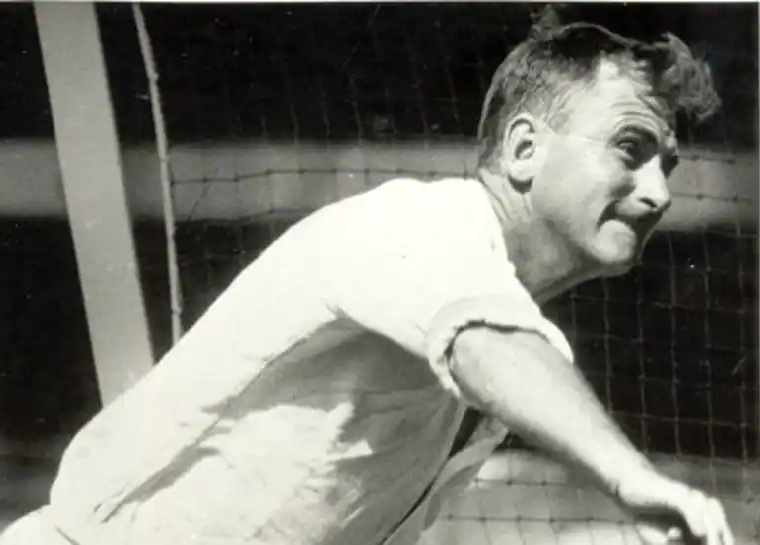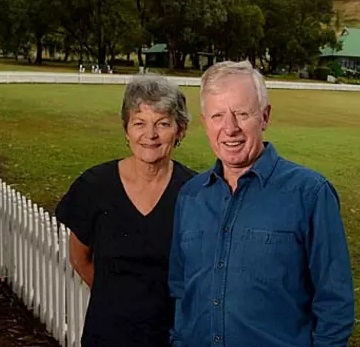Peter Philpott – cricket icon
John Rogers | March 06, 2023

The prospect of batting against Peter Philpott’s bowling always brought a dose of butterflies.
Would he make a fool of you? Misread his wrong-un? Stumped yards out of the crease? Hanging forward like a stick insect as the ball dropped in front of you and spun away?
Played with your mind, did Percy.
He exuded an air of complete confidence in his craft. He’d set fields with authority, take his time, and make you wonder what he was up to. Then after a few short, slow skips, he would toss up his delivery – and it would whirr.
“Like a bloody bumblebee!” his victims would grumble, as it buzzed towards them. He spoke of getting it over the “high bar”, or above the batsman’s eye-line. And it seemed to hang in the air in front of them, daring batsmen to leave the crease. When it landed, it would turn sharply away, so often missing a probing bat. Stumped off Philpott, was a regular read in the Sunday papers, and I confess my first outing against him read just that. And if the batsmen looked thoroughly frightened and unlikely to leave his crease, then a flipper or a straight one would be aimed at the pads next ball. LBW Philpott, was the result of my second outing against him.
Almost a cricketing version of ‘float like a butterfly, sting like a bee’, was Percy Philpott.
Bowling slow leggies is the toughest of all the cricket skills. So many of us have tried, can spin the ball like a top, even bowl the unplayable like Warne’s “Gatting Ball”, or the perfect wrong-un that dips at the last movement swings away from the batsman and then spins back between bat and pad to hit middle stump. But landing wrist-spin on a good length regularly over 22 metres is no easy task. If you miss your mark, and the ball has to be fetched from over the fence, your time at the bowling crease will decrease rapidly.
And even the best can struggle as Warne did against Tendulkar. A memory for me is of the famous day Sobers, off the back foot planted Meckiff into the Sheridan stand at the SCG in 1961. Sobers scored 168 that day and was in his absolute pomp. Alan Davidson could just contain him and it was up to Benaud to do the bowling at the other end as Sobers was simply smashing the others. Periodically Sobers would crash Benaud delivery to the fence and Richie was using all his wiles with quicker balls, wider ones, flippers - holding on by the skin of his teeth – absolutely mesmerising cricket.
All of which makes Peter Philpott’s rise to test cricketer an extraordinary achievement.
He was part of a great flowering of talent in NSW in the 1950s that resulted in a run of 9 consecutive seasons winning the Sheffield Shield. NSW’s immediate post-WW2 teams were full of toughened soldier types and in their place came Depression-born kids who thrived under the leadership Victorian expat Keith Miller. He changed NSW cricket out of Bradman-style relentlessness and imposed a care-free, entertainment focus that fitted with Miller’s war-time “I might be dead tomorrow” philosophy. With quality senior players about – not the least Arthur Morris, Neil Harvey and Miller himself - youngsters flourished. Four of them became an auto choice in any world Test team: Benaud, Davidson, O’Neill, Simpson. There were other really decent test cricketers– Booth, Rorke, Craig, Burke, Misson, Martin, Watson, Thomas. And in an era when getting a Sheffield Shield cap with all these big boys, was a huge challenge, there were helluva good state players like Sid Carroll, Warren Saunders, Neil Marks, Ron Kissell, Noel Hughes, Bobby Madden, Ray Flockton and several more.
And right in the mix of such talented cricketers was Peter Philpott, perhaps the least imposing physically and with a rheumatic fever history to boot.
Yet he was the youngest of the lot to play 1st grade cricket in Sydney – at 15.
And he was there plying the most difficult of all the cricket skills – wrist-spin.
And if you play 1st grade at 15, you also have to be able to bat. And that means fast bowlers which for most 15 year old kids is terrifying.
Survive and flourish he did. A regular room-mate for him on tour was Warren Saunders who told me of the day of their long partnership together in a 2nd XI game against Victoria at Junction Oval. “Percy got a double hundred that day, while I got 96”, he recalled, adding that Percy could really bat. His four hundreds for NSW are testimony to that, some of them coming at the top of the order. On top of that he was a quality fielder in slips.
So how did he do it?
When meeting up with quality cricketers, an obvious physical characteristic will stand out. Glen McGrath’s height is always a bit of a shock. Shane Warne has immensely strong shoulders and wrists, so they say. Norm O’Neill was similar as his rocket throws from the boundary showed. Doug Walters had a whipcord look about him - wiry strength from his dairy-milking.
Percy? His legs didn’t look particularly long, nor his arms, and ‘slight’ probably described his build. So clearly it was his innate skill, but it must also have been what was above the shoulders. Yet he wasn’t cerebral in the sense of being ‘away with the birdies’, but there was no doubt that he played cricket with his head. He studied opponents, worked out how best to make life difficult for them, and played to a plan whether batting or bowling.
Often when he was chosen for NSW there were another 4 wrist-spinners in the team. Four! After pace bowlers Davidson & Misson or similar had finished, Benaud might bowl, or left arm tweaker Little Johnny Martin, while Bob Simpson and Norm O’Neill would both be demanding a bowl, each considering themselves good enough to be a front-line test spinner. Occasionally so many players were jousting for positions Percy would miss out – but not for long. He batted so well, fielded so well and teased out quality batsman so often, that he was always in the mix for the top team. A surprise outcome of T20 cricket is that so many legspinners are prominent when everyone expected them to be hit out of the game. Would Percy have survived in today’s T20 stuff? You betcha. He’d have found ways and means to confound the Chris Gayle big hitters, though he’d cop a bit in the process.
Like nearly all his contemporaries, he was great company. It’s called “culture” these days, but those 1950s/60s cricketers played the game in the best possible spirit. Yet it was oh-so-tough, but extremely fair. After play, disappointments and achievements would be put aside and each other’s company enjoyed. Percy was a standout. He was interesting, and he was interested. He’d talk to every player, from top-dog to lowest – properly.
And he had a party-trick.
He’d spent three seasons playing with Ramsbottom in the Lancashire League and was immensely popular, and there he’d picked up the Lancashire inflections. Back in Australia the legendary on Jack Chegwyn country tours, he was an absolute standout. After Jimmy Burke had imitated Elvis via the piano, Ray Flockton do his race-call, Percy would recite the poem “The Lion & Albert” that starts like this
There’s a famous seaside place called Blackpool,
That’s noted for fresh-air and fun,
And Mr and Mrs Ramsbottom
Went there with young Albert, their son.
Here’s the link http://holyjoe.org/poetry/edgar.htm
Percy did it so well with all the inflections, that the guys never tired of it and at quiet moments on tour he’d be asked to recite it.
While still playing, Percy was building a very good record as a coach. In my early days in Sydney Grade cricket, players from the private schools were rarely successful. Some 16 years later there were lots at my grade club at UNSW and elsewhere, most inspired in some way by Percy Philpott via his stints at Shore or at Kings, or just generally via coaching classes he always seemed to be running in addition to his mainstream teaching. He would have brought a touch of realism to the schoolboy scene that had been lacking for so long.
Gradually the role of a coach at cricket was gaining respectability and Percy became one of the first to be appointed as coach of a Sheffield Shield team. Then came the ultimate, Australian team coach for the Ashes Tour of 1981. Somehow I think Percy would regard it as a career lowlight rather than a highlight.
Then living in Perth as WACA general manager, I could see that World Series Cricket had changed the Australian cricket culture. There was a much harder edge than before, born out of the battle with the Australian cricket establishment and the physical challenge posed by the never-ending stream of West Indian fast bowlers that WSC needed as quality opposition. WSC’s Ian Chappell’s famous statement that “the coach is something the players ride in to and from the ground”, was alive and well, and I’ve little doubt it was carried out to the letter by many in the team. They will never know what they missed.
Undeterred Percy carried on with his coaching, including a move to coach the South Australian team for three years.
So was he a good coach?
A dozen people in my small network – unprompted – have spoken about him with great warmth.
My favourite story about his coaching originates from the time when his great friend Richie Benaud headed into retirement in the early 60s. A Benaud clone arrived on the Queensland scene by the name of Bob Paulsen. He had a similar wonderful action and spun the ball hard. Initial results were good and he was named as a chance for the 1968 Ashes tour, but gradually tapered, lost his place and moved to WA. He was good against touring teams but not Shield opposition, so again found himself back in the grade ranks.
In the late 1970s and now past the 30 mark, he joined up with a social cricket tour to Africa and found Percy Philpott as a team-mate. He credits Percy with re-educating him in the art of leg-spin bowling. Out went “toss-‘em-up” attitudes, ring-field-placings and ‘short leg’ fieldsmen, as he learned to bowl Philpott style and “not be hit into the next suburb” as had been his history. He returned to grade cricket as a far better bowler, twice being the leading wicket-taker which he’d never been near before - and much more economical than ever before. “If only I’d played with Percy early in my career,” he would lament.
As a Cricket Australia Director, Bob saw his role as helping spin bowling and one year in the early 2000s arranged for Percy to come to Perth. He asked if I would put him up for a week.
At the end of the week my wife and I wondered where it had gone, we enjoyed his company so much. He was a delight to have, and wonderful company, as ever.
A quality person, and an ornament on the game of cricket, was Peter Philpott.








